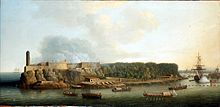Siege of Havana
The siege of Havana lasted from June 13th to August 13th, 1762. It took place as part of the Seven Years War and ended with the capture of the Spanish city by the British.
prehistory
On the basis of an alliance between the Spanish and French Bourbons , Charles III stepped . entered the Seven Years War on the French side in 1762. This happened at a time when the war was in fact over in most theaters of war. The main overseas bases were Havana in Cuba and Manila , the capital of the Philippines . The British war strategy was directed against both cities. The command of the fleet destined for Havana was given to Vice-Admiral George Pocock . When he sailed from Portsmouth , he had a fleet of 70 war and transport ships. Other ships joined them on the way. When the fleet arrived off Havana on June 6, there were over 200 ships, including fifty warships. The transport fleet transported an army of around 14,000 soldiers.
Havana was heavily fortified and was considered impregnable. The city was protected by the citadel Castillo de la Real Fuerza and the Fort La Punta. There was also the fortress Castillo de los Tres Reyes del Morro (usually called El Morro) beyond the port entrance, which could control the entire area. The Spanish defenders had about 4,000 regular soldiers and sailors. There were also 3,000 militia troops. The Spanish commander was Juan de Prado y Portocarrero Malleza .
course
The real key position was the El Morro fortress, which could only be attacked from land. The British landed east and west of Havana on June 7th. The British Army Commander George Keppel, 3rd Earl of Albemarle , succeeded in taking the hill La Cabaña on June 10th to gain an important strategic position. The fortress of El Morro was subsequently shelled by British guns for over a month. Also in view of the impending hurricane season and the own high losses, especially due to tropical diseases, it seemed impossible to besiege and starve the fortress for a long time. So Keppel decided to attack directly. For this purpose the walls were undermined and equipped with explosive mines. Before the attack, Keppel made the Spanish commander Don Luis de Velasco one last offer of surrender, which he did not accept. On July 30th the mines were detonated. After that, the British troops attacked. During the first attack, Velasco and his deputy fell. The defenders then gave up.
The British now shelled the city itself from both the fortress and from the hill La Cabaña. The city was not surrendered until August 13th. The Spanish units were allowed to leave the city with their flags, weapons and their possessions. Some officers were even brought back to Spain by ship. The residents of the city were offered, if they wanted to stay, that they could become British citizens after four years. They were assured that they would practice the Catholic religion without restriction.
consequences
Under British control, Havana experienced a strong economic boom, triggered by the lifting of all trade restrictions with the North American colonies and Great Britain. Much of Cuba remained under Spanish control.
In addition to eleven Spanish warships, the British fell into their hands with large quantities of trade goods and several million pesos in silver. The victory, however, cost the British dearly. Of the soldiers originally landed, only 3,000 were still operational. The number of those killed was comparatively low at around 400. The number of prisoners was similarly high. But about 10,000 fell ill with malaria , yellow fever and other tropical diseases. Later about 5000 soldiers died from it.
Keppel became governor of the occupied territories in Cuba. News of the victory in Havana reached London on September 27 and sparked great enthusiasm in Great Britain. Conversely, the defeat was a great shock for Spain, as it had succeeded in conquering the strategically most important city in the West Indies. The city remained under British control for eleven months before reverting to Spain in the Peace of Paris of 1763.
Since the hill La Cabaña had proven to be a weak point in the defense of the city and port, the Spanish King Carlos III ordered. after the recovery, the construction of the huge fortification Fortaleza de San Carlos de la Cabaña .
Web links
literature
- Paul K. Davis: Defeated. An Enzyclopedia of great Sieges from ancient times to the present , Santa Barbara 2006 pp. 167-171.
- Marian Füssel: The Seven Years War. A World War in the 18th Century , Munich 2010 pp. 79–81.
- David Greentree: A Far-Flung Gamble. Havana 1762 (Raid 15), Oxford 2010.
- David Syrett: The siege and capture of Havana 1762 (Publications of the Navy Records Society 114), London [u. a.] 1970.
- Michael Zeuske: Kleine Geschichte Kubas , Munich 2002 pp. 56–58.


